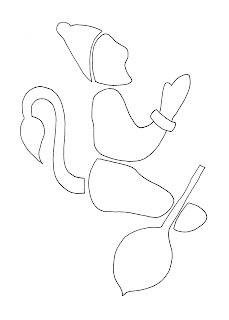© 2008 This project is dedicated to Gurudev.
For use in Balavihar classrooms (or personal use) only.
Click on image to view enlarged.
This papier mache Lord Ganesha was made by Balavihar students and parents for our 2008 End of the Year Program.
This is definitely an art project to do outdoors -- where kids can get creative and MESSY.
Below are the material list and instructions to make a wall hanging.
Materials
2 Dinner paper plates (heavy duty)
Roll of masking tape
A couple of sheets of newspaper (or newsprint)
Strips of newspaper (or newsprint -- about 1/2 to 1 inch wide)
aluminum foil (optional)
Paste*
Tempera Paints**
Paint brush
Containers (for paints and brush water)
* To make your own paste: Mix 1 part flour to 3 parts water in a medium sized pot. Whisk well so that all lumps are gone. Cook on the stove until you get a nice, smooth consistency (like oatmeal.) Let cool, before using. (Once cooled, you can add a little elmer's glue, if you want. This is a nice way to keep little insects from eating your paper while it's drying.)
**Add some Elmer's glue to the tempera paint if you want to make it more resistant to water. Also, it will give the paint a shinier finish. (Artist's acrylic medium is also a good option, but costs more.)
Directions
To create your Lord Ganesha form: Cut one paper plate in half (each of these pieces will be used as an ear.) Tape each ear to either side of the other paper plate. (see photo A) Take a couple of sheets of newsprint and roll them together, tightly, to make his trunk. Tape his trunk into place on the paper plate. Now make his tusks. This can be done easily by using aluminum foil. (If you do use aluminum foil, make sure that you completely cover the foil with masking tape -- otherwise you are going to have a struggle making the paper stick when you begin pasting.)
Photo A
If you want Ganesha's face to have a more roundish form, add some paper to the center of the plate (until you have the shape you want) and tape it in place. (see Photo A)
Once you are satisfied with your form, then you are ready to papier mache. Take a strip of paper and tear it into pieces (a couple of inches is nice). Dip your fingers into the paste and smooth it onto the form. Add your paper strip and smooth it down. (Use more paste, if needed**). Be sure that when you paste the paper on you get all the wrinkles out. You want a nice smooth surface. Remember, when this sculpture dries, it will harden. If there are wrinkles when it is wet, then there will be hard wrinkles when it is dry. Also, be careful not to allow any open gaps between the paper plates ... everything gets covered with paper. You want to create a seamless work of art. (see Photo B)
**Be careful not to use too much paste. A few kids had some mold growing in super pasty areas. This is a very tactile art process, and sometimes kids really get into the pasting part. "Just enough paste" is a good rule of thumb.
Completely papier mache one side of the face. Let it dry. Turn over and paste the other side. Ideally, you would like to have 2 or three coats of paper before considering the sculpture finished and ready for decorating.
Photo B
Once Ganesha is thoroughly dry, bring out the paints and have a blast!
The above wall hangings were made by Balavihar summer campers.

















































